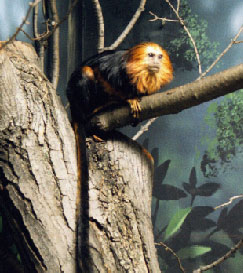The golden-headed lion tamarin has nonopposable thumbs and the nails are claw-like except for the first digit on each toe. This species has golden hair on its face and forelimbs (Kinzey, 1997). This species has long digits used in the forging small insects and vertebrates (Garber, 1992). The mean adult body mass is around 500-550 grams (Rylands, 1993).
RANGE:
The golden-headed lion tamarin is found in the country of Brazil, and lives in the tall evergreen broadleaf tropical forests and semideciduous forests of the Atlantic coast (Rylands, 1993).


